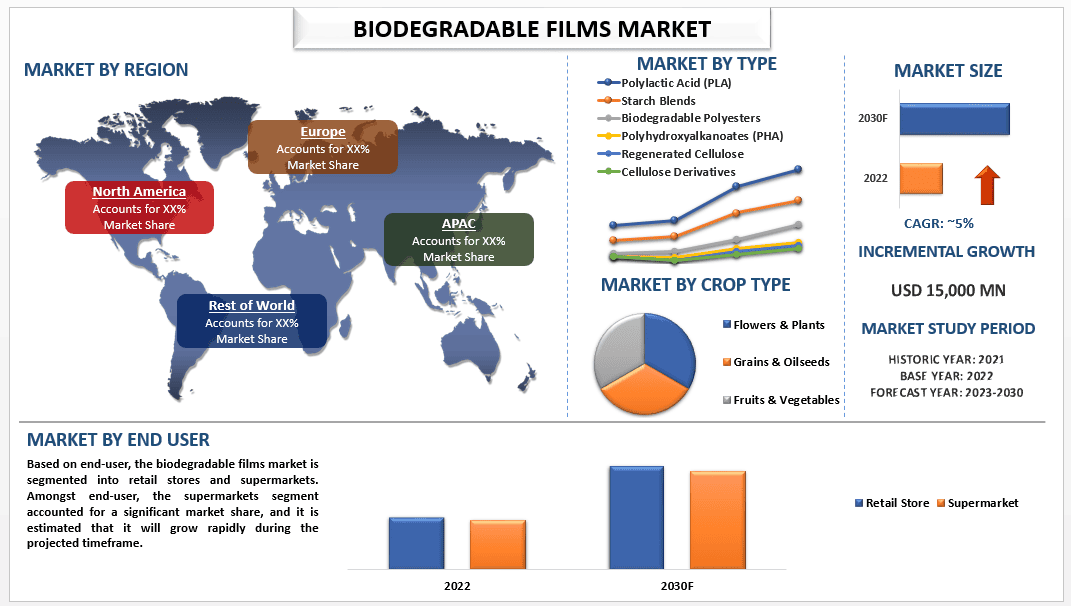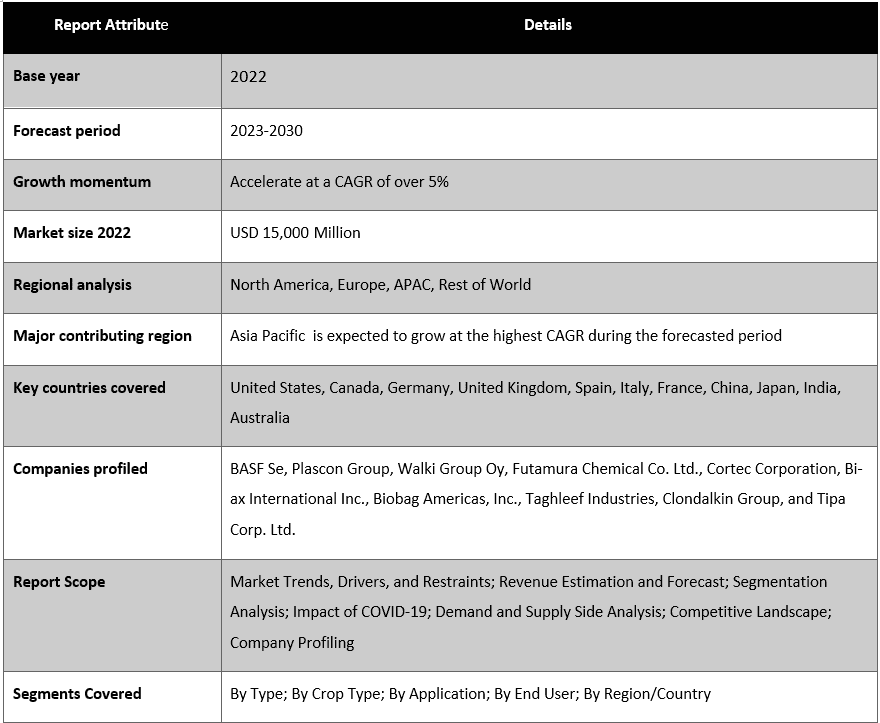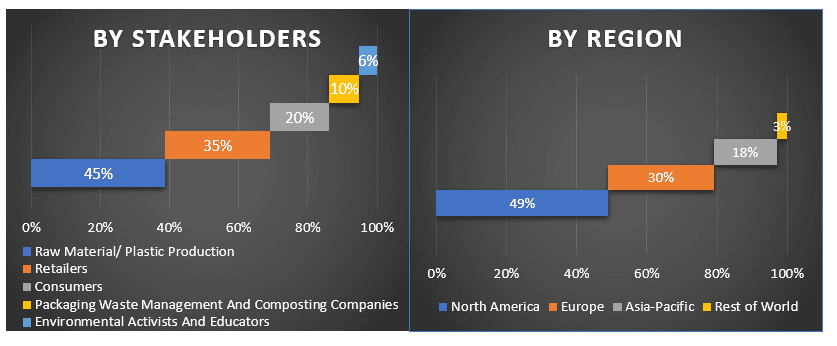- Home
- About Us
- Industry
- Services
- Reading
- Contact Us
Biodegradable Films Market: Current Analysis and Forecast (2023-2030)
Emphasis on Type (Polylactic Acid (PLA), Starch Blends, Biodegradable Polyesters, Polyhydroxyalkanoates (PHA), Regenerated Cellulose, Cellulose Derivatives); Crop Type (Flowers & Plants, Grains & Oilseeds, Fruits & Vegetables); Application (Food Packaging, Cosmetic & Personal Care Products Packaging, Agriculture & Horticulture, Industrial Packaging, Other); End User (Retail Store, Supermarket); Region/Country

Biodegradable Films Market is expected to exceed the market valuation of more than US$ 15,000 million in 2022 and is expected to grow at a significant CAGR of approximately 5% during the forecast period (2023-2030). Biodegradable polymers also known as biodegradable films has been increasing in popularity in the development of new materials as an alternative solution to the environmental problems which are caused by the accumulation of non-degradable synthetic containers. Due to this, much effort has been made to develop biodegradable or edible films from biopolymers to produce an environmentally friendly packaging alternative to synthetic plastic packaging films. The films are first modeled as solid sheets, which are made from natural polymers and once it was formed, it can be placed on or between food components. The biodegradable films can be prepared using protein, polysaccharide, or lipid materials. Manufacturers can also incorporate antimicrobial or antioxidant agents in films and these can be used as active packaging. These biodegradable films/edible films have numerous advantages over the conventional synthetic packaging materials.
Biodegradable films are degraded naturally by the influence of natural parameters like moisture, microbes, oxygen and sunlight. Such films byre invented to eliminate threats such as atmospheric pollution and landfill generations which are caused be non-biodegradable plastic films. Biodegradable films are mainly manufactured by the chemical replacement of carbon chains in the materials that are being used to manufacture plastic films, so the degradation process happens faster than in the case of normal plastics. Environmental awareness and their long-term availability are boosting the demand of biodegradable films. According to a research, approximately 100-200 million tons of plastic is present is oceans, with 8 million tons entering the water every year. Additionally, the slowly decreasing prices of biodegradable films are also increasing their popularity. However, the cost of plastic films is comparatively way lower which is hampering the demand of biodegradable films. Another challenge with biodegradable films is their inability to degrade when certain environmental conditions are not met.
Insights Presented in the Report
“Amongst Type, Biodegradable Polyesters segment holds the major share”
Based on Type, the Biodegradable Films market is segmented into Polylactic Acid (PLA), Starch Blends, Biodegradable Polyesters, Polyhydroxyalkanoates (PHA), Regenerated Cellulose, and Cellulose Derivatives. Biodegradable Polyesters are further sub-segmented into Polycaprolactone (PCL) and Polybutylene Adipate Terephthalate (PBAT). The starch blend segment accounted for a significant market share and it is estimated that it will grow rapidly during the projected timeframe as they are excellent biodegradable fillers for their thermal stability property and for making minimal interference with the melt-flow properties of most materials.
“Amongst Crop Type, Fruits and Vegetables Segment holds the major share”
Based on Crop Type, the Biodegradable Films market is segmented into Flowers & Plants, Grains & Oilseeds, and Fruits & Vegetables. Amongst crop types, the Fruits and Vegetables segment accounted for a significant market share. This can be attributed to the ease of application owing to the perennial nature of crops. Additionally, the use of biodegradable agricultural films helps solve various environmental issues, such as harmful waste disposal caused by conventional plastic films. Furthermore, efforts have been taken to cultivate high-quality food crops, which provide a better yield, to cater to the rising demand due to the increased per capita consumption of food..
Biodegradable Films Market Report Coverage

“Amongst Application, Food Packaging and Generation segment holds the major share”
Based on application, the Biodegradable Films market is segmented into Food Packaging, Cosmetic & Personal Care Products Packaging, Agriculture & Horticulture, Industrial Packaging, and Other Applications. Amongst applications, the food packaging segment accounted for a significant market share. This can be attributed to the increasing demand for eco-friendly packaging solutions and the growing awareness of the harmful effects of conventional plastic packaging on the environment. Biodegradable films are used in various food packaging applications such as egg trays, edible coatings, paper boards, wrapping films, and food containers. The use of biodegradable films in food packaging helps reduce waste and pollution, making it a sustainable and environmentally friendly option.
Reasons to buy this report:
- The study includes market sizing and forecasting analysis validated by authenticated key industry experts
- The report presents a quick review of overall industry performance at one glance
- The report covers an in-depth analysis of prominent industry peers with a primary focus on key business financials, product portfolio, expansion strategies, and recent developments
- Detailed examination of drivers, restraints, key trends, and opportunities prevailing in the industry
- The study comprehensively covers the market across different segments
- Deep dive regional level analysis of the industry
Customization Options:
Biodegradable Films market can further be customized as per the requirement or any other market segment. Besides this, UMI understands that you may have your own business needs, hence feel free to connect with us to get a report that completely suits your requirements.
Table of Content
Research Methodology for the Biodegradable Films Market Analysis (2023-2030)
Analyzing the historical market, estimation of the current market, and forecasting the future market of the Biodegradable Films market were the three major steps undertaken to create and analyze the adoption of Biodegradable Films in major regions globally. Exhaustive secondary research was conducted to collect the historical market numbers and estimate the current market size. Secondly, to validate these insights, numerous findings and assumptions were taken into consideration. Moreover, exhaustive primary interviews were also conducted, with industry experts across the value chain of the Biodegradable Films market. Post assumption and validation of market numbers through primary interviews, we employed a top-down/bottom-up approach to forecasting the complete market size. Thereafter, market breakdown and data triangulation methods were adopted to estimate and analyze the market size of segments and sub-segments the industry pertains to. Detailed methodology is explained below:
Analysis of Historical Market Size
Step 1: In-Depth Study of Secondary Sources:
Detail secondary study was conducted to obtain the historical market size of the Biodegradable Films through company internal sources such as annual report & financial statements, performance presentations, press releases, etc., and external sources including journals, news & articles, government publications, competitor publications, sector reports, third-party database, and other credible publications.
Step 2: Market Segmentation:
After obtaining the historical market size of the Biodegradable Films market, we conducted a detailed secondary analysis to gather historical market insights and share for different segments & sub-segments for major regions. Major segments included in the report as type, crop type, application, and end-user. Further country-level analyses were conducted to evaluate the overall adoption of Biodegradable Films in that region.
Step 3: Factor Analysis:
After acquiring the historical market size of different segments and sub-segments, we conducted a detailed factor analysis to estimate the current market size of Biodegradable Films. Further, we conducted factor analysis using dependent and independent variables such as increasing environmental awareness and willingness to invest on biodegradable products. A thorough analysis was conducted for demand and supply-side scenarios considering top partnerships, merger and acquisition, business expansion, and product launches in the Biodegradable Films sector across the globe.
Current Market Size Estimate & Forecast
Current Market Sizing: Based on actionable insights from the above 3 steps, we arrived at the current market size, key players in the Biodegradable Films market, and market shares of the segments. All the required percentage shares split, and market breakdowns were determined using the above-mentioned secondary approach and were verified through primary interviews.
Estimation & Forecasting: For market estimation and forecast, weights were assigned to different factors including drivers & trends, restraints, and opportunities available for the stakeholders. After analyzing these factors, relevant forecasting techniques i.e., top-down/bottom-up approach was applied to arrive at the market forecast about 2027 for different segments and subsegments across the major markets globally. The research methodology adopted to estimate the market size encompasses:
- The industry’s market size, in terms of value (US$) and the adoption rate of Biodegradable Films across the major markets domestically
- All percentage shares, splits, and breakdowns of market segments and sub-segments
- Key players in the Biodegradable Films market in terms of products offered. Also, the growth strategies adopted by these players to compete in the fast-growing market
Market Size and Share Validation
Primary Research: In-depth interviews were conducted with the Key Opinion Leaders (KOLs) including Top Level Executives (CXO/VPs, Sales Head, Marketing Head, Operational Head, and Regional Head, Country Head, etc.) across major regions. Primary research findings were then summarized, and statistical analysis was performed to prove the stated hypothesis. Inputs from primary research were consolidated with secondary findings, hence turning information into actionable insights.
Split of Primary Participants in Different Regions

Market Engineering
Data triangulation technique was employed to complete the overall market estimation and to arrive at precise statistical numbers of each segment and sub-segment of the Biodegradable Films market. Data was split into several segments & sub-segments post studying various parameters and trends in the areas of type, and their type of the Biodegradable Films market.
The main objective of the Biodegradable Films Market Study
The current & future market trends of Biodegradable Films were pinpointed in the study. Investors can gain strategic insights to base their discretion for investments from the qualitative and quantitative analysis performed in the study. Current and future market trends were determined the overall attractiveness of the market at a regional level, providing a platform for the industrial participant to exploit the untapped market to benefit as a first-mover advantage. Other quantitative goals of the studies include:
- Analyze the current and forecast market size of Biodegradable Films in terms of value (US$). Also, analyze the current and forecast market size of different segments and sub-segments
- Segments in the study include areas of type and their subtypes
- Define and analysis of the regulatory framework for the Biodegradable Films industry
- Analyze the value chain involved with the presence of various intermediaries, along with analyzing customer and competitor behaviors of the industry
- Analyze the current and forecast market size of the Biodegradable Films market for the major region
- Major regions studied in the report include North America (the U.S, Canada, and Rest of North America), Europe (Germany, United Kingdom, France, Spain, Italy, and Rest of Europe), Asia-Pacific (China, Japan, India, Australia, and Others), and the Rest of the World
- Company profiles of the Biodegradable Films market and the growth strategies adopted by the market players to sustain in the fast-growing market
Deep dive regional level analysis of the industry
Related Reports
Customers who bought this item also bought










